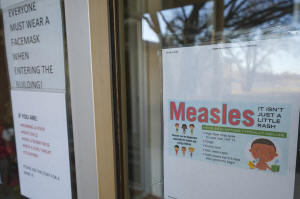Measles cases continue to rise in rural parts of West Texas, with 124
confirmed
 [February 26, 2025]
By DEVI SHASTRI [February 26, 2025]
By DEVI SHASTRI
BROWNFIELD, Texas (AP) — The measles outbreak in rural West Texas has
grown to 124 cases across nine counties, the state health department
said Tuesday, and 18 people are hospitalized.
The outbreak is largely spreading in the Mennonite community in an area
where small towns are separated by vast stretches of oil rig-dotted open
land but connected due to people traveling between towns for work,
church, grocery shopping and other day-to-day errands.
Brownfield Mayor Eric Horton, a Republican, said he believes in the
safety of the measles, mumps and rubella (MMR) vaccine because it has
been used for so many years and has stopped measles from spreading in
the U.S.
Brownfield is in Terry County, which has 21 cases.
“I’ve never seen it this close, ever,” Horton said. “I know that we’ve
had a few outbreaks in years past but as far as right here, making
national news, that is shocking.”
In neighboring eastern New Mexico, the measles case count stayed steady
Tuesday at nine. State public health officials said last week there's
still no evidence New Mexico's outbreak is connected to the one in
Texas.
Measles is a highly contagious disease. Here's what you should know
about how to protect yourself against measles, as well as what's
happening in Texas and New Mexico.

Where is measles spreading?
Tuesday's count in West Texas went up by 34 cases since Friday. Cases
continue to be concentrated in Gaines County, which has 80 infections,
and Terry County, north of Gaines, where there are now 21.
Dawson County, to the east of Gaines, has seven; Yoakum County has five;
Ector County has two; and Lubbock and Lynn counties have a case each.
Martin County, also near Gaines, is new with three cases.
The state also said there are four cases in Dallam County, which is in
the far corner of the state's Panhandle area and a couple hundred miles
north of Gaines County, and potential exposures in mid-February from an
infected, contagious person who traveled to San Marcos, San Antonio and
New Braunfels.
Texas health department data shows the vast majority of cases are among
people younger than 18: 39 infections are in kids younger than 4 and 62
are in kids 5-17 years old. Eighteen adults have measles and five cases
are “pending” an age determination.
State health officials have said this outbreak is Texas' largest in
nearly 30 years. Cases have been concentrated in a “close-knit,
undervaccinated” Mennonite community, health department spokeswoman Lara
Anton has said — especially among families who attend small private
religious schools or are homeschooled.
A Brownfield resident and father of three told The Associated Press that
he’s not too concerned about the outbreak.
“I only found out because it was a word-of-mouth thing,” said Dylan
Cruz, 28, whose children are vaccinated against measles.
In New Mexico, all the cases are in Lea County, which borders Gaines
County in Texas. The state health department has said people may have
been exposed at a grocery store, an elementary school, a church, Nor-Lea
Hospital and a Walgreens in Hobbs, New Mexico.
What is measles?
Measles is a respiratory virus that can survive in the air for up to two
hours. Up to 9 out of 10 people who are susceptible will get the virus
if exposed, according to the U.S. Centers for Disease Control and
Prevention.
Most kids will recover from the measles if they get it, but infection
can lead to dangerous complications like pneumonia, blindness, brain
swelling and death.
[to top of second column]
|

A sign is seen outside a clinic with the South Plains Public Health
District Sunday, Feb. 23, 2025, in Brownfield, Texas. (AP
Photo/Julio Cortez)

Is the vaccine safe?
The MMR vaccine is safe and highly effective in preventing measles
infection and severe cases of the disease.
The first shot is recommended for children between 12 and 15 months old
and the second between 4 and 6 years old. The vaccine series is required
for kids before entering kindergarten in public schools nationwide.
Before the vaccine was introduced in 1963, the U.S. saw some 3 million
to 4 million cases per year. Now, it’s usually fewer than 200 in a
normal year.
There is no link between the vaccine and autism, despite a
now-discredited study and health disinformation.
Why do vaccination rates matter?
In communities with high vaccination rates — above 95% — diseases like
measles have a harder time spreading through communities. This is called
“herd immunity.”
But childhood vaccination rates have declined nationwide since the
pandemic and more parents are claiming religious or personal conscience
waivers to exempt their kids from required shots.
The U.S. saw a rise in measles cases in 2024, including an outbreak in
Chicago that sickened more than 60. Five years earlier, measles cases
were the worst in almost three decades in 2019.
Gaines County has one of the highest rates in Texas of school-aged
children who opt out of at least one required vaccine, with nearly 14%
of K-12 children in the 2023-24 school year. Health officials say that
number is likely higher because it doesn’t include many children who are
homeschooled and whose data would not be reported.
What are public health officials doing to stop the spread?
New Mexico health officials are hosting vaccination clinics on Wednesday
and Thursday.
In Texas, the U.S. Centers for Disease Control is providing “technical
assistance, laboratory support and vaccines as needed,” the agency told
the AP. But the state health department is taking the lead in the
outbreak investigation.

Workers in the West Texas region are hosting regular vaccination clinics
and screening efforts, and also said they're working with schools to
educate people about the importance of vaccination and offering shots.
Dr. Martin Ortega is a family medicine physician for Texas Tech
Physicians of the Permian Basin-Odessa in in Ector County, where the
county health department told the Odessa American that a child too young
to be vaccinated got the measles.
Ortega said the vast distances between people in West Texas is a unique
challenge for health officials.
“It is something that puts us on a shared higher alert because we are
interconnected and we don’t see ourselves as that far from each other,”
he said.
___
Associated Press videojournalist Mary Conlon contributed to this report.
All contents © copyright 2025 Associated Press. All rights reserved |